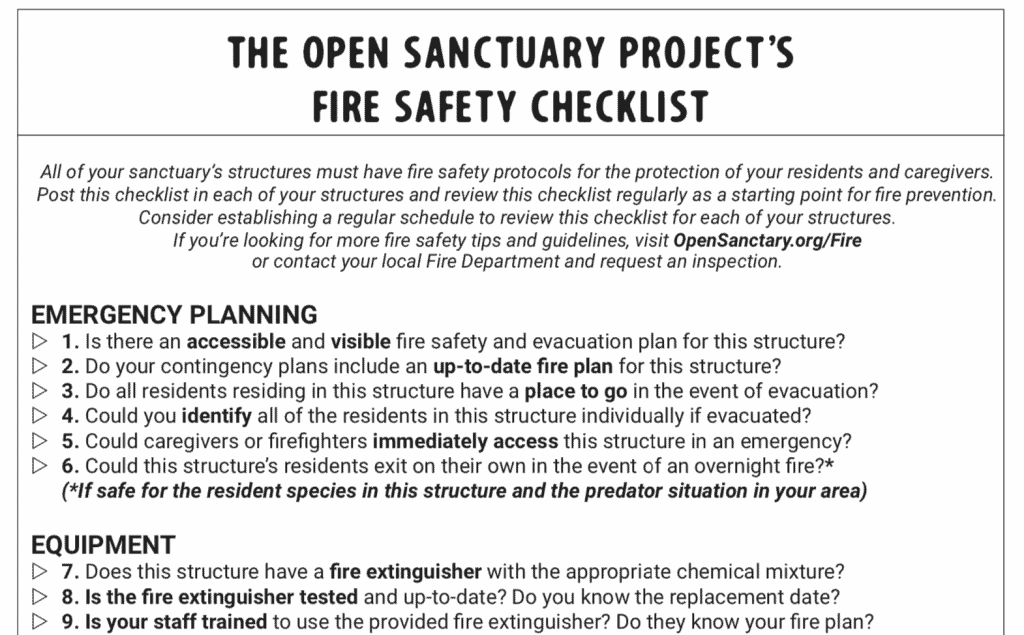
(July 29, 2019) – We’ve updated this form based on feedback from the community! Make sure to download the newest version if you’ve previously downloaded this form.
Enter your organization’s (or your) name and email below to download a free printable checklist to help prevent fires at your sanctuary. Reviewing this list for every structure (or developing your own checklist) should be a regularly scheduled part of your sanctuary’s operations!
We promise not to use your email for any marketing purposes! Would you prefer to access this form in a different way? Contact us and let us know!
Have you used this form at your sanctuary and want to give us your feedback on improvements? Let us know here!
Check out our full resource about fire prevention at your animal sanctuary here!
Full Text Of This Resource
The Open Sanctuary Project’s Fire Safety Checklist
All of your sanctuary’s structures must have fire safety protocols for the protection of your residents and caregivers. Post this checklist in each of your structures and review this checklist regularly as a starting point for fire prevention. Consider establishing a regular schedule to review this checklist for each of your structures.
If you’re looking for more fire safety tips and guidelines, visit OpenSanctary.org/Fire
or contact your local Fire Department and request an inspection.
EMERGENCY PLANNING
1. Is there an accessible and visible fire safety and evacuation plan for this structure?
2. Do your contingency plans include an up-to-date fire plan for this structure?
3. Do all residents residing in this structure have a place to go in the event of evacuation?
4. Could you identify all of the residents in this structure individually if evacuated?
5. Could caregivers or firefighters immediately access this structure in an emergency?
6. Could this structure’s residents exit on their own in the event of an overnight fire?*
(*If safe for the resident species in this structure and the predator situation in your area)
EQUIPMENT
7. Does this structure have a fire extinguisher with the appropriate chemical mixture?
8. Is the fire extinguisher tested and up-to-date? Do you know the replacement date?
9. Is your staff trained to use the provided fire extinguisher? Do they know your fire plan?
10. Could you minimize or eliminate prolonged use of extension cords in this structure?
11. Do all of your power outlets have functional constant use covers in this structure?
12. If you use smoke detectors, are they free of dust, tested, and operational?
13. Ensure residents are not directly accessing or creating nests on top of heating elements.
14. Avoid prolonged use of any exposed heating elements if at all possible in this structure.
MAINTENANCE
15. Check for and repair any exposed or falling insulation in this structure’s walls or ceilings.
16. Check any heaters, fans, and tools for inconsistent operation or sparking.
17. Ensure that all exposed wiring is encased in conduit, check all conduit for damage.
18. Replace and reinforce any wire or device that has been chewed on by rodents.
19. Check auto-waterers for exposed heating elements or damaged wires.
20. Ensure heated auto-waterers are pig-proof if pigs have access to them.
CLEANING
21. Have you dusted in this structure recently, especially around electrical or heat sources?
(Remember: ceramic heaters and heat lamps can never have dust on or in them!)
22. Ensure backup power generators are clean and far away from any flammable materials.
23. Clean any flammable liquid spills or leaks, such as oil, immediately and thoroughly.








